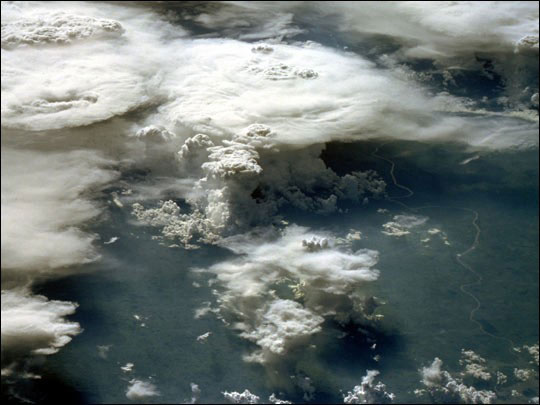
(http://www.gsfc.nasa.gov/gsfc/earth/pictures/20020915iristheory/t-storm.jpg)
Mission 2006: Saving the Rainforest
Climate

(http://www.gsfc.nasa.gov/topstory/20020915iristheory.html)Mass DeforestationA major influence in the disruption of the climate in the amazon is deforestation. There are two forms of deforestation; one is deforestation in patches and the other is mass deforestation. It is uncertain whether the net effect of either of them is global cooling or global warming but recent satellite measurements from the TRMM(Tropical Rain Measuring Mission) of CERES(Clouds and the Earth's Radient Energy System) indicate that the results of mass deforestation would be global warming.
I worked primarily on the effects of mass deforestation on the climate. The driving force for climate change in this case is increase in temperature and decrease in moisture. When an area of trees is cleared, the humidity in that region decreases because trees aren't there to hold and pull moisture out of the soil. Thus, there is not enough moisture in the air and rainfall decreases significantly. This results not only in a drier region in the vicinity of the deforestation but also in wetter regions thousands of miles away from the area that was deforested.(Ball, 1) This is because normally rain is formed through water vapor condensation, which releases heat. Heat causes convection, or hot air rising. That hot air travels far distances and lands thousands of miles away, making those areas drier. With less humidity and convection in the Amazon, places as far as the US can become wetter due to the absence of this hot air.(Ball,2) Thus, deforestation in the Amazon produces a planetary wave and has a global effect.There are two hypotheses that predict the net results of having less humidity and more heat in the atmosphere. They both agree that clouds in a warmer region will be smaller and thinner due to lack of moisture. They will cover less area and will be less effective at blocking the sun. However, whether this causes global cooling or global warming is highly debatable.
There are two opposing effects caused by less cloud covereage. Fewer clouds in the atmosphere will allow the earth to release heat more efficiently since clouds will not be there to trap the heat. At the same time, fewer clouds results in less blocking of the sun's radiation. The Iris hypothesis argues that the heat released due to these clouds is much more than the extra heat let in by these clouds so the net effect is global cooling. (Rink, 1) This would be a great negative feedback system for climate control. (Gutro, 2) The warmer the atmosphere becomes, the more heat the earth releases. However, results from the Tropical Rainfall Measuring Mission(TRMM) satellite launched by NASA suggest the opposite. CERES has modeled the exchange of energy and has found that the amount of heat let in by these clouds is more than the amount of heat that escapes due to these clouds. Measurements show that there is weak positive feedback due to these clouds instead of strong negative feedback.(lin, 5) Thus the net effect is actually more global warming. (Earth Observatory, 1)
Patchy Deforestation
When patchy deforestation occurs, as is the case in most situations, the loss of humidity is less of an issue . The areas around the deforested area are very humid still and will make up for the lost moisture. The main effect that will result from that deforestation is that the temperature difference between the deforested(more irradiated and thus warmer) regions and undeforested (cooler) regions will cause more clouds to form. These clouds tend to be higher than normal clouds that would form in that region because hot air raises higher than warm air. This can be shown thru a diagram of clouds over warm and cool regions of the ocean since humidity is not a factor in this case.
Obviously, warmer regions have higher, larger clouds. The effect of having more clouds is still not completely determined and depends on the characteristics of that particular cloud. ( Gutro, 2) (Date of publication is September 18, 2002) Zach Gazak covered more recent studies on these clouds. For more information, please see his webpage in the Mission 2006 website.
Sources:1) Ball, Phillip. Making Waves. Nature. Macmillan Magazines Ltd, 2 October 2000.
2) Rink, Chris. NASA Satellite Instrument Warms Up Global Cooling Theory. NASA News Archive. January 16, 2002.
http://earthobservatory.nasa.gov/Newsroom/NasaNews/2002/200201167312.html3) Gutro, Rob. Study Finds Thicker Clouds Over Warmer Tropical Waters Affect Climate. 9/18/2002. http://www.gsfc.nasa.gov/topstory/20020915iristheory.html
4) Evidence Against the Iris Hypothesis. Earth Observatory, NASA. http: //earthobservatory.nasa.gov/Study/Iris/iris2.html
5) Lin, Bin, Bruce A Wielicki, Lin H. Chambers et al. The Iris Hypothesis: A Negative or Positive Clouds Feedback? Journal of Climate: Vol 15, No. 1, pp.3-7
6) Sellers, PJ., RE Dickinson, DA Randall et al. Modeling the Exchanges of Energy, Water and Carbon Between Continents and the Atmosphere. Science: Vol 275, p502-509. January 24, 1997.